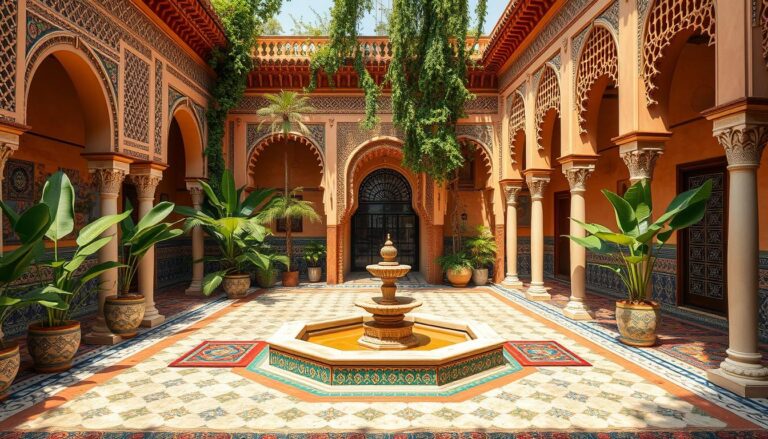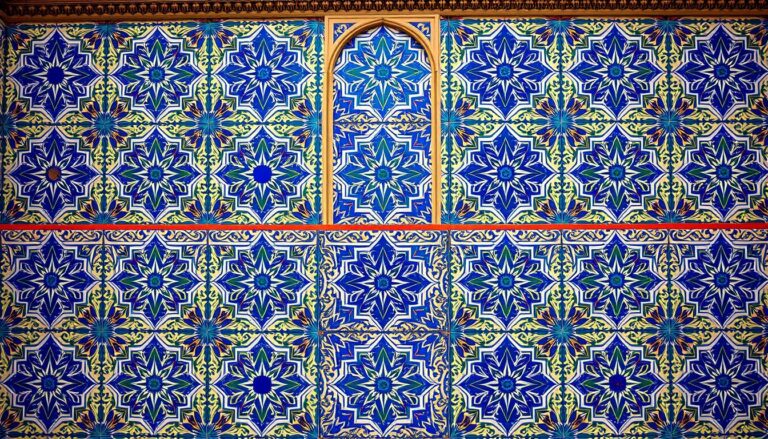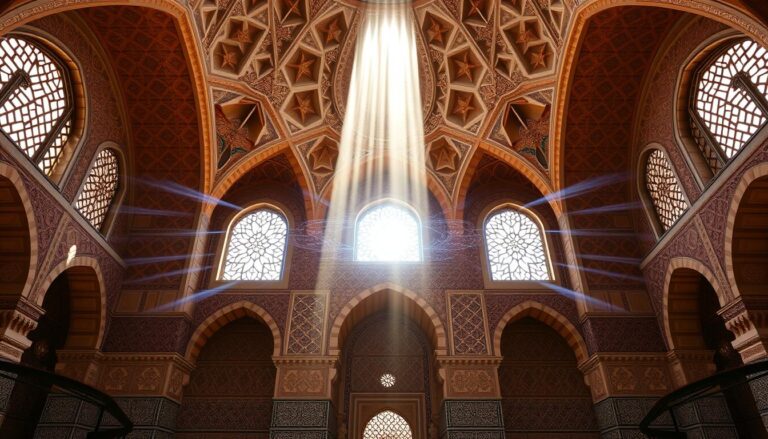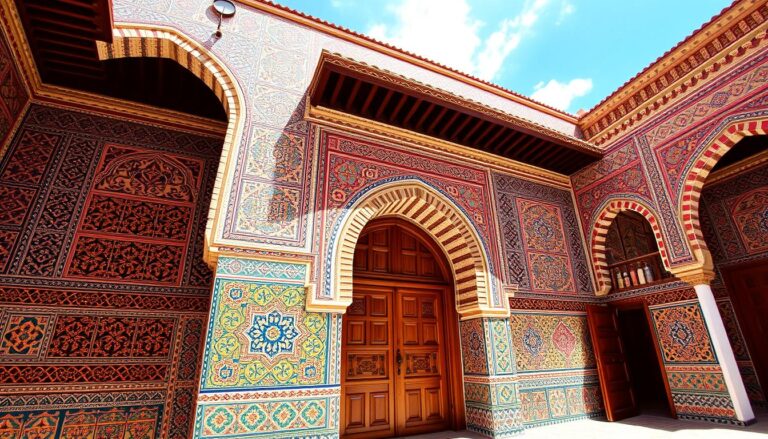What secrets hide in Morocco’s ancient medinas? These historic areas, especially in Fez, have fascinated many. They show a mix of cultures from centuries of Islamic rule and more. From Fez’s start in the 8th century to the Almoravid and Almohad empires’ architectural touches, Morocco’s ancient medinas are a window into the past.
Here, traditional building methods and Islamic urban planning blend perfectly. This creates a unique and captivating environment.
Key Takeaways
- Moroccan ancient medina architecture reflects diverse cultural influences from the Idrisid, Almoravid, and Almohad dynasties.
- The historic city of Fez, founded in 789 CE, is renowned for its intricate courtyards, winding alleyways, and use of traditional building materials.
- Moroccan medina architecture showcases the masterful integration of Islamic urban planning with vernacular building techniques.
- Ornamental woodwork, masonry vaults, and zellij tilework are hallmarks of the architectural style developed under the Marinid dynasty.
- The ancient medinas of Morocco, such as the UNESCO-listed Medina of Fez, continue to captivate visitors with their enduring beauty and cultural significance.
Origins and Evolution of Moroccan Medina Architecture
The Moroccan medina architecture has deep roots. It goes back to the founding of Fez in the late 8th century by the Idrisid dynasty. This Berber family started two walled settlements on both sides of the Oued Fes river. This was the start of the modern medina.
The Almoravid and Almohad empires greatly influenced Moroccan architecture. In the 11th-13th centuries, they expanded and fortified Fez. They also built important monuments like the Al-Qarawiyyin and Andalusi mosques. These mosques showed the Moorish arch and were inspired by Kairouan and Cordoba.
The Idrisid Dynasty: Founding of Fez
Fez, now a UNESCO World Heritage Site, was founded by the Idrisid dynasty in the late 8th century. This Berber family created two walled settlements on the Oued Fes river. This was the start of the modern medina and its rich architecture.
Almoravid and Almohad Influences
The Almoravid and Almohad empires had a big impact on Moroccan architecture. In the 11th-13th centuries, they expanded and fortified Fez. They built famous monuments like the Al-Qarawiyyin and Andalusi mosques. These mosques featured the Moorish arch and were inspired by Kairouan and Cordoba.
“Moroccan architecture traces back to 110 BCE with the influences of the Berber Kingdom of Mauretania, known for large buildings erected from mud bricks (pise).”
The Essence of Moroccan Ancient Medina Architecture
Moroccan ancient medina architecture is a mix of winding alleys and courtyard houses. This style shows the Islamic way of building, focusing on community and privacy.
Winding Medina Alleyways and Courtyard Houses
Fez’s historic medina is the largest in the world, with over 10,000 alleys. These narrow paths lead to peaceful courtyard houses. They are built to face inward, offering a quiet escape from the outside world.
Fès el-Bali, the oldest part of Fez, is a key part of the city’s history. It shows the lasting impact of Moroccan medina architecture. The Medina of Fez is also the biggest pedestrian area globally, highlighting its cultural and architectural importance.
Islamic Urban Planning and Vernacular Building Techniques
Moroccan ancient medina architecture combines Islamic planning with local building methods. It uses mudbrick, masonry vaults, and detailed woodwork. This creates a unique look that has lasted for ages.
The souks in Fez’s Medina show the architecture’s flexibility. Each area focuses on different goods, like leather or copper. The Tanners’ Souk and Seffarine Square are examples of these specialized markets, keeping the area’s traditions alive.
“The Medina of Fez is a testament to the enduring power of traditional Islamic urban planning and the skilled craftsmanship of Moroccan artisans. Each alleyway and courtyard house tells a story of a vibrant, resilient community that has thrived for centuries.”
Moroccan Ancient Medina Architecture: A Multicultural Tapestry
Moroccan ancient medina architecture is a mix of many cultures, woven over centuries. Andalusian immigrants and the Almoravid, Almohad, and Marinid eras have shaped its unique look. This blend creates the enchanting Moorish design found in the ancient medinas.
The use of zellij (mosaic tilework) is a standout feature. It started in the Almoravid and Almohad eras. This colorful tilework adorns walls, floors, and ceilings, making structures visually stunning.
The Marinid period, from the 13th to 15th centuries, also made a big impact. It saw the building of grand madrasas and ornate structures. These buildings show the mix of Andalusian architecture and Moroccan influences.
“Moroccan ancient medina architecture is a tapestry of diverse cultural influences, woven together over centuries.”
Today, Morocco’s ancient medinas, like Fez, show off this rich multicultural heritage. Visitors can explore winding alleys, find hidden courtyards, and see the lasting craftsmanship.
The beauty and cultural importance of Moroccan ancient medina architecture amaze people worldwide. It shows the strength of blending diverse influences and keeping the past’s architectural legacy alive.
Fez: The Jewel of Moroccan Ancient Medina Architecture
Fez is a historic city with two main areas: Fez el-Bali and Fez el-Jdid. Fez el-Bali, the older part, is a UNESCO World Heritage site. It’s known for its medieval look and many historic sites. Fez el-Jdid, built in the 13th century, has a royal citadel and madrasas that show off the architectural skills of that time.
Fez el-Bali: A UNESCO World Heritage Site
Fez el-Bali, the old town, has been a UNESCO World Heritage site since 1981. It has a medieval feel with narrow streets and historic buildings. Founded in 789, it’s a lively place with a rich culture.
Architectural Marvels of Fez el-Jdid
Fez el-Jdid was built by the Marinid dynasty in the 13th century. It has a royal citadel and madrasas that show off the Marinid style. The Medersa Bou Inania is a standout with its beautiful tilework and design.
Fez is a treasure of Moroccan heritage. It has the UNESCO-recognized Fez el-Bali and the amazing architecture of Fez el-Jdid. This city takes you back in time and inspires visitors from everywhere.
“Fez is a magnificent and enchanting city, a true time capsule of Moroccan history and culture.” – Lonely Planet
Moroccan Ancient Medina Architecture: Blending Tradition and Modernity
Morocco is changing, and its old medina buildings are getting a new look. Architects are using old cooling tricks and local materials to make new, green buildings. These buildings keep the old charm of Morocco’s buildings but are also good for the planet.
This mix of old and new is shaping Morocco’s future buildings. The Hassan II Mosque in Casablanca is a great example. It combines Moroccan styles with modern touches, making it a stunning sight.
“The ongoing marina development project along the Bouregreg river valley aims to create public and tourist spaces, including the construction of the Grand Theater designed by Zaha Hadid, set to be completed in 2019.”
But not everyone likes all the new buildings. Oussama, a student in Rabat, worries about the Grand Theater’s impact. He sees the need to balance keeping traditions alive with bringing in new ideas.
The l’Ecole Supérieure de Technologie de Guelmim in the south is a great example. It shows how old and new can work together. The building uses cool tricks, local materials, and saves energy. It was even up for the Aga Khan Award in 2016.
Morocco’s old medina buildings are a symbol of the country’s ability to mix the old with the new. They show how important traditional techniques and sustainable architecture are in its modern buildings.
Preserving the Legacy of Moroccan Ancient Medina Architecture
Keeping Moroccan ancient medina architecture alive is a big challenge. These historic places face dangers like decay, too many people, and bad city growth. The Moroccan government, with help from the Ministry of Culture, is working hard to save places like the Medina of Fez. They want to fix damaged buildings, support green growth, and keep this amazing culture and architecture safe for the future.
Conservation Efforts and Challenges
Keeping Moroccan ancient medina architecture safe needs a lot of work and facing many problems. For example, the Ait Benhaddou Ksar, built in the 11th century, needs constant fixing to stay standing. The Taourirt Kasbah, built in 1754, also needs regular upkeep to stay in good shape.
But, the Moroccan government and local groups are dedicated to saving these historic sites. They are working to keep old building ways and designs alive. This is seen in the mix of Islamic and colonial styles at the Mohammed VI Museum of Modern and Contemporary Art in Rabat.
Also, there’s a push for sustainable development. The Ecodome houses in Benslimane, near Rabat, show this. Architects are using old methods in new ways to make homes that are good for the planet. They use cool designs and materials from around there.
“The architectural evolution in Morocco involves a mix of tradition, innovation, and sustainability.”
Protecting Moroccan ancient medina architecture is a complex task. It needs careful balance between saving, fixing, and meeting today’s needs. By finding this balance, Morocco can keep these UNESCO World Heritage site wonders alive for future generations.
Conclusion: The Enduring Beauty of Moroccan Ancient Medina Architecture
Moroccan ancient medina architecture shows the lasting impact of tradition, culture, and innovation. It combines old designs and building methods with new, eco-friendly architecture. This mix keeps the architectural legacy alive and inspiring.
Morocco looks to the future while honoring its rich past. Its medinas, like those in Marrakech, Fez, and Rabat, blend Islamic, Moorish, and Berber styles. This creates a unique cultural mix that has endured for centuries.
The ancient medinas of Morocco are more than just old buildings. They are a living part of the country’s spirit. With their winding alleys, beautiful mosques, and lively food scenes, they enchant and educate visitors. They ensure the architectural wonders of Morocco will be celebrated for many years.
Source Links
- Moroccan architecture
- Architecture of Fez
- The Rich and Vibrant History of Moroccan Architecture.
- A brief history of Moroccan riads – Marrakech Riads | Site Officiel
- The Medina of Fez, a labyrinth that conserves the essence of Morocco – Barceló Experiences
- Moroccan Charm: A Timeless Journey Through Marrakech’s Ancient Medinas – Vision Times
- Discovering the Magnificence of Morocco’s Medina Marvels : A Cultural Odyssey Through Souks, Riads, and Grand Mosques – MSITRAVELS
- Fes A Cultural Moroccan City
- Fez: UNESCO World Heritage Series – Journey Beyond Travel
- The Imperial City Of Fez, Morocco
- Fez Insiders Guide, Travel Tips & Secrets of the Ancient Medina – Morocco Travel Blog
- Fes Morocco: Beyond the Medina | Buddha Drinks Fanta
- An Exploration of Modern Moroccan Architecture – The Yale Globalist
- Discover the Marvels of Moroccan Architecture
- Learning from the ancients, modern Moroccan architecture forges new identity | Africanews
- Preserving Islamic Architecture in Fez, Morocco – The Continents States University
- Morroco | Culture Seekers
- Exploring the Medina of Morocco: A Cultural Journey | African Sahara

The Editorial Team is a passionate group of Morocco enthusiasts dedicated to sharing the beauty, culture, and wonders of this captivating country. With diverse backgrounds and a deep love for travel, we strive to bring you engaging and informative content that inspires your Moroccan adventures. From uncovering hidden gems and sharing local insights to exploring mouthwatering cuisine and showcasing the vibrant lifestyle, our team is committed to providing you with valuable resources and exciting stories that enhance your exploration of Morocco. Join us on this journey as we celebrate the rich heritage and unforgettable experiences that make Morocco truly special.







